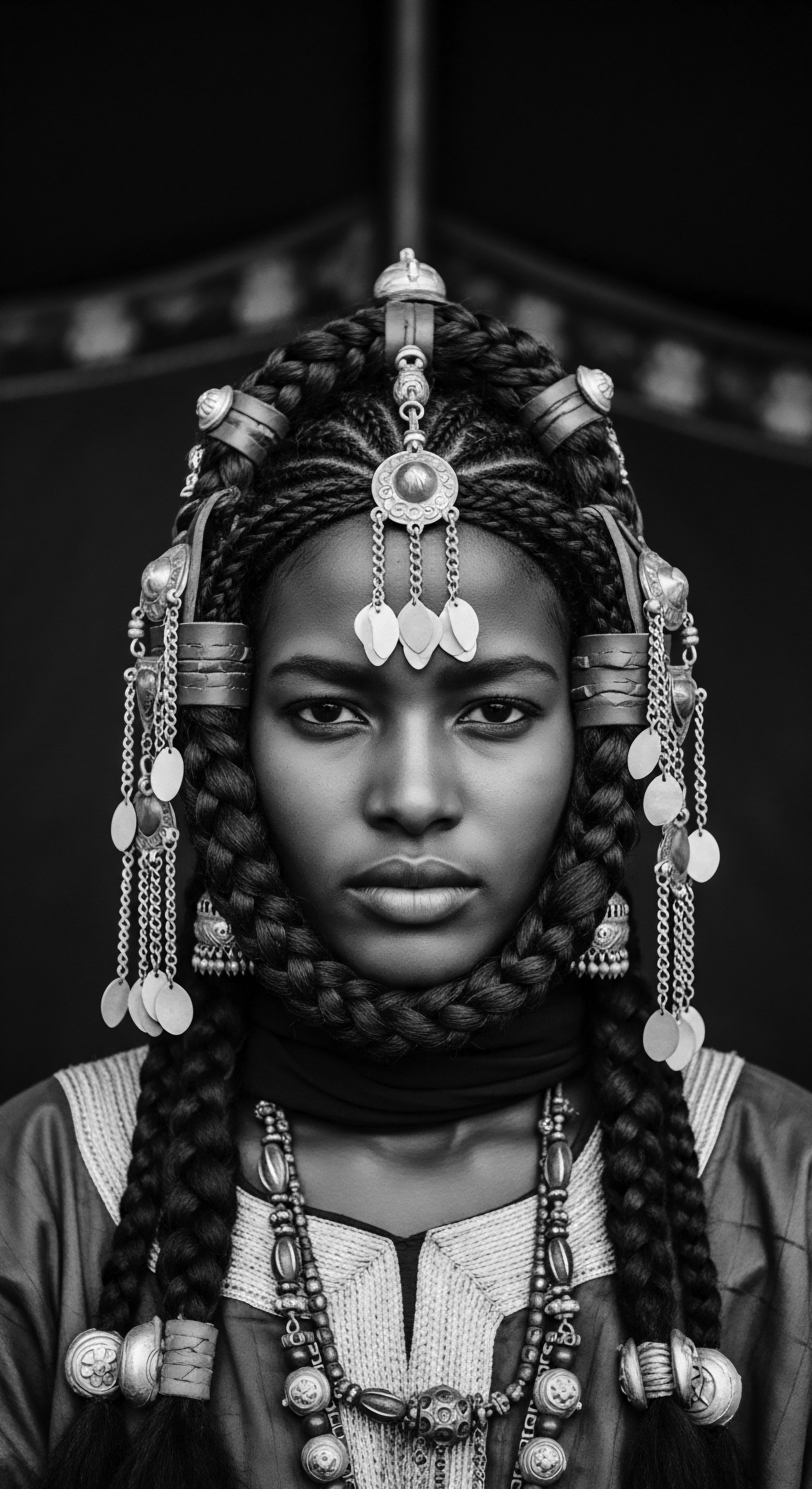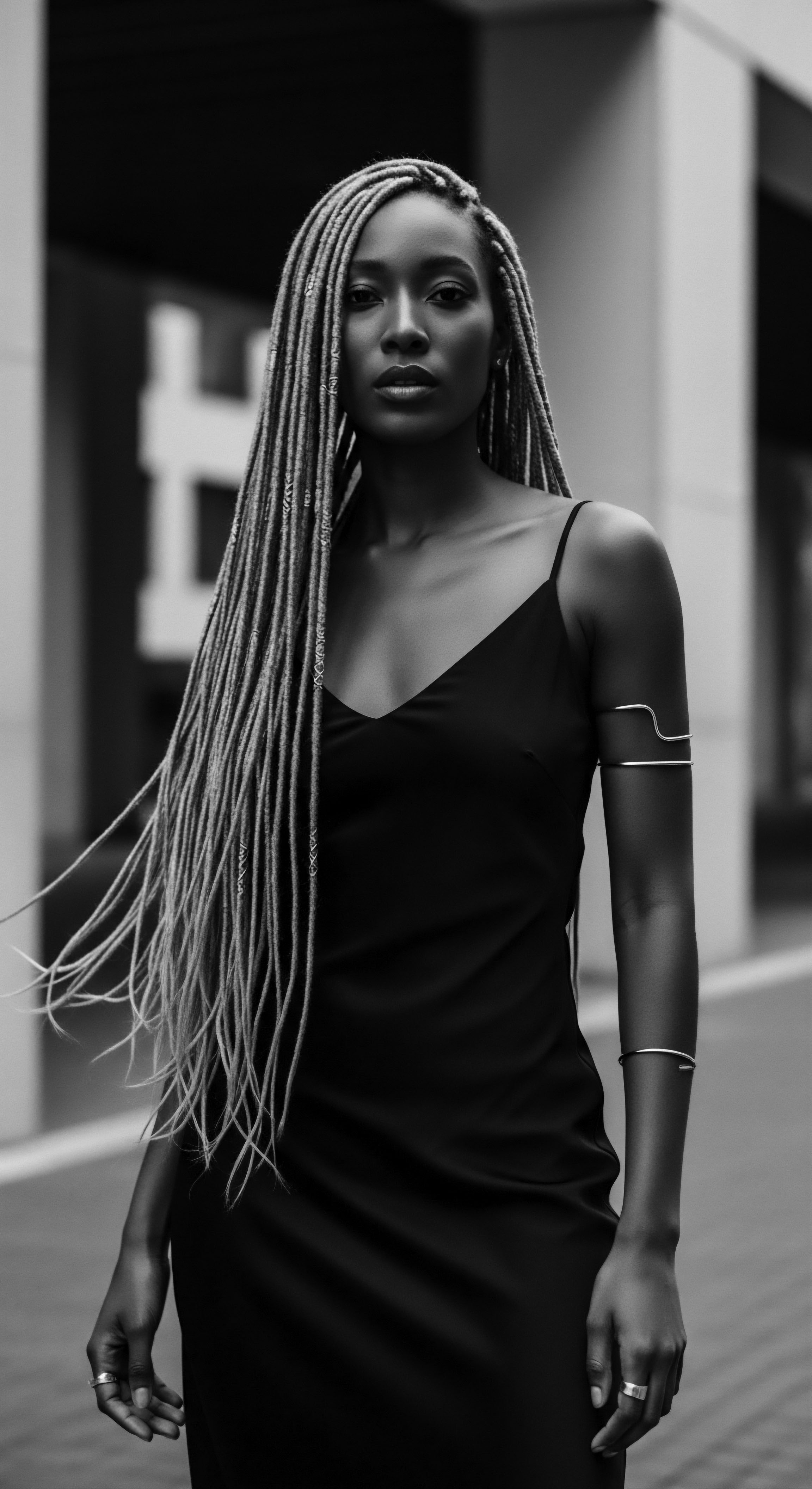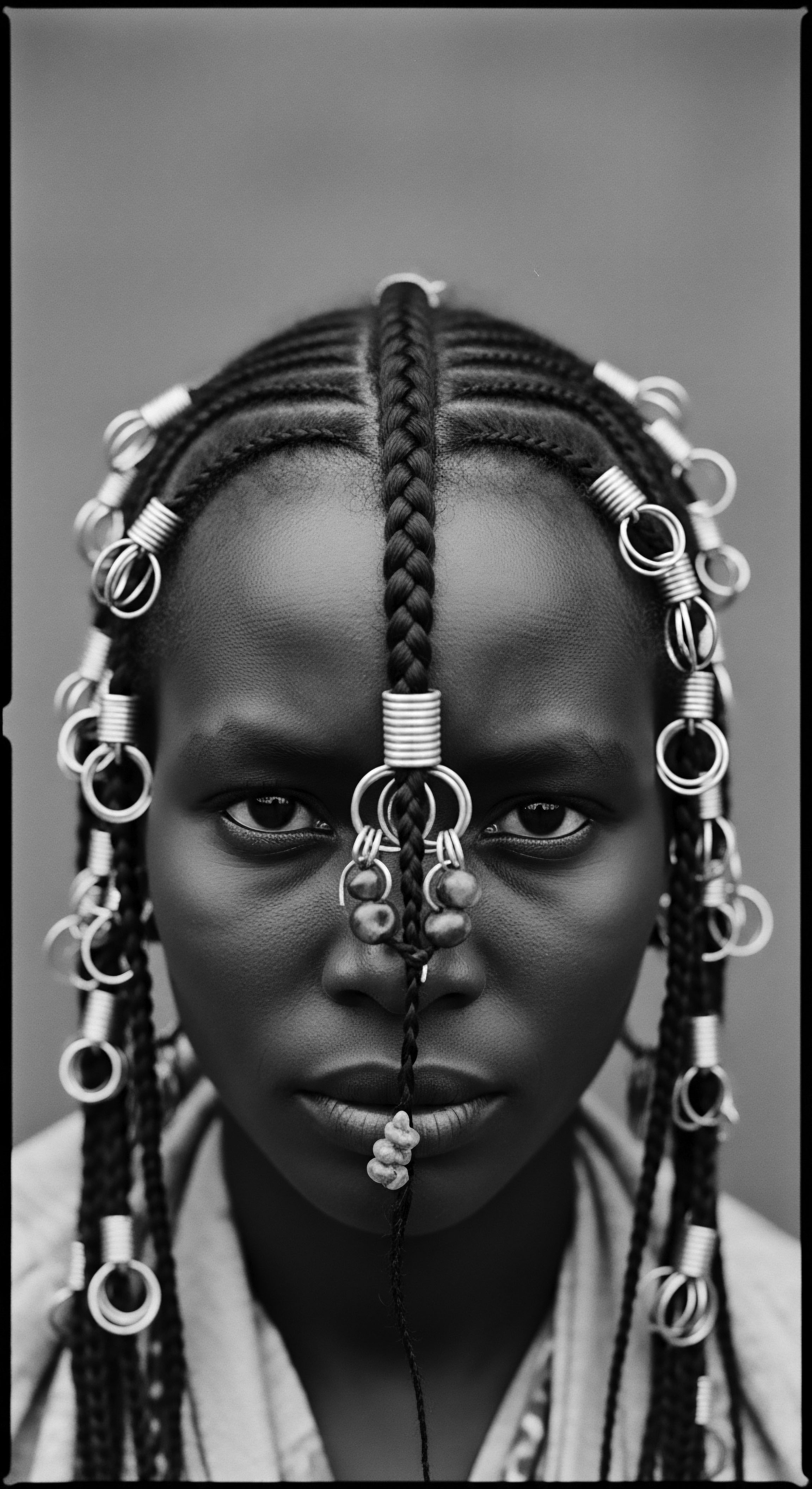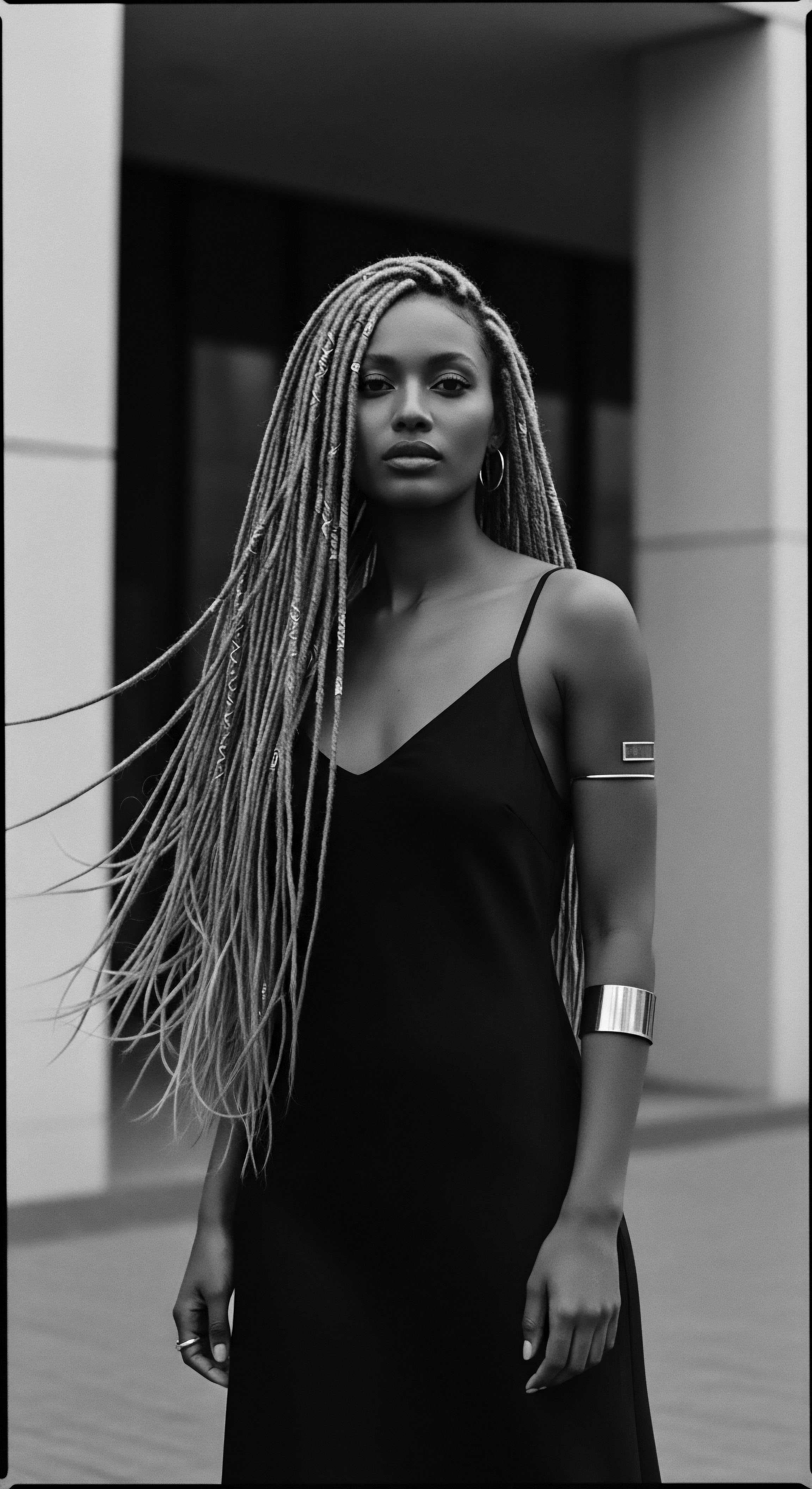
Fundamentals
The understanding of hair often begins at the elemental level, observing its visible transformation. The appearance of silver strands, those shimmering filaments that catch the light, represents a gradual shift in the hair’s inherent coloration. This occurrence, widely recognized as greying, marks a natural biological progression within the human body. From a straightforward standpoint, the Silver Hair Meaning refers to this very process ❉ the diminishment or complete cessation of melanin production within the hair follicles.
Melanin, the pigment responsible for our hair’s distinct shades, exists in two principal forms—eumelanin, which provides black and brown tones, and pheomelanin, contributing red and yellow hues. As the melanocytes, the specialized cells producing these pigments, become less active over time, or indeed, cease their function entirely, the hair strand emerges devoid of color. It then takes on a translucent quality, appearing silver or white against the darker, still pigmented hairs around it. This natural progression is a universal aspect of the human experience, a visible chronicle of a life unfolding.
Beyond the physiological definition, the initial interpretation of silver hair often extends to straightforward associations with age. For many, a burgeoning crown of silver serves as a visual marker of advancing years, of time’s passage. It is a sign perceived readily across various human societies. In its most fundamental sense, therefore, the Silver Hair Meaning is understood as a literal representation of seniority and the accumulation of lived experience.
It is a surface reading, yet it holds undeniable truth. This basic understanding provides a foundational layer upon which more complex cultural, spiritual, and historical interpretations are built, particularly within communities where hair carries inherited significance.

Intermediate
Moving beyond the simplest interpretation, the Silver Hair Meaning begins to acquire deeper dimensions, especially when viewed through the lens of textured hair heritage. Here, the scientific understanding of hair greying intertwines with profound cultural perspectives that have long informed Black and mixed-race hair experiences. The biological shift from pigmented to unpigmented hair is not merely a cosmetic change; it is often perceived as a marker of a journey, a visual record of wisdom earned and resilience embodied. The intricate spirals and coils of textured hair, even as they transition to silver, retain their inherent structure, their unique character.
The science behind hair’s transition to silver, while fundamentally about melanocyte activity, is a complex interplay of genetic predispositions, oxidative stress, and the gradual decline of enzyme systems that protect these pigment-producing cells. Each strand’s gradual lightening signals a shift in the cellular environment within the follicle. This natural phenomenon, however, finds varied cultural reception, particularly where hair has served as a communication system and a symbol of identity.
Within numerous ancestral traditions, the emergence of silver strands was not a signal for concealment, but rather a visible attribute inviting honor and respect. This perspective stands in contrast to beauty standards that often valorize an unchanging, youthful appearance.
The appearance of silver strands in textured hair embodies a continuous narrative of time, wisdom, and ancestral connection, extending beyond mere biological change.

Cultural Narratives of Silver Hair
Across the African diaspora, the Meaning of silver hair has been layered with symbolism that honors tradition and lineage. It has frequently signified a person’s ascent into elderhood, a revered position in communal life. Elders, recognized by their silvered crowns, were often entrusted with the preservation of oral histories, the resolution of disputes, and the spiritual guidance of their communities.
The very sight of silver hair in a gathering often commanded immediate attention, signaling the presence of someone whose insights were shaped by decades of accumulated knowledge and experience. This cultural regard elevates silver hair from a simple biological fact to a sacred badge of honor.
- Wisdom’s Halo ❉ In many West African societies, the silvering of hair, especially in a man’s beard, was directly correlated with increased wisdom and spiritual insight. Such individuals were considered closer to the ancestors, possessing a unique conduit to ancient knowledge.
- Lineage Marker ❉ Silver hair could often denote an individual’s respected position within a family lineage, indicating their role as a living link between past generations and future ones. This visible alteration served as a reminder of an unbroken chain of existence.
- Resilience Display ❉ For Black and mixed-race individuals, especially within the context of historical adversities, silver hair has acquired an added Connotation of resilience. Each silver strand might be seen as a testament to struggles navigated, triumphs achieved, and unwavering endurance through challenging times.
The traditional care practices surrounding hair, including silver hair, further illuminate its profound cultural Import. Indigenous communities frequently employed natural ingredients and rituals, not merely for cosmetic purposes, but also to nourish the hair as a spiritual and social entity. These practices underscore a holistic view of well-being where the physical body is interconnected with ancestral wisdom and communal identity.
| Traditional Care Practices Application of natural oils (e.g. shea butter, palm oil) to maintain softness and sheen. |
| Contemporary Approaches (Heritage-Informed) Use of plant-based cleansers and conditioners formulated specifically for silver textured hair. |
| Traditional Care Practices Herbal infusions (e.g. black tea, indigo) to enhance natural tones or subtly camouflage silver. |
| Contemporary Approaches (Heritage-Informed) Exploration of natural hair dyes for gradual, low-impact color transitions. |
| Traditional Care Practices Communal grooming rituals, often accompanied by storytelling and knowledge sharing. |
| Contemporary Approaches (Heritage-Informed) Emphasis on self-care and mindful hair routines that honor personal heritage and well-being. |
| Traditional Care Practices Both historical and current approaches recognize the necessity of gentle care, reflecting a sustained respect for the inherent qualities of silver textured hair. |
Understanding the Silver Hair Meaning at this intermediate level requires recognizing the intersection of biology, cultural interpretation, and historical experience. It moves beyond a simple definition of appearance to encompass its significance as a narrative of a life lived, a heritage honored, and a wisdom shared within communities where hair remains a potent symbol.

Academic
The academic exploration of the Silver Hair Meaning transcends superficial aesthetic considerations, delving into its profound anthropological, sociological, and ontological implications, particularly within the expansive context of Black and mixed-race hair heritage. From an academic perspective, the Silver Hair Meaning constitutes a semiotic complex, a visible manifestation of bio-cultural aging that encodes layers of social capital, ancestral memory, and identity negotiation within specific communal frameworks. It represents a nuanced interplay between the universal physiological process of melanogenesis cessation and the diverse, culturally constructed interpretations that confer upon it spiritual authority, social hierarchy, and symbolic resilience. This definitional scope requires rigorous examination of how societies, particularly those of African descent, have historically rendered meaning from this corporal transformation, elevating it beyond a mere marker of chronological age to a profound emblem of accumulated wisdom, lineage continuity, and enduring communal ties.
The biological process of hair greying, or canities, stems from a reduction in melanin synthesis by melanocytes in the hair follicle bulb, alongside an increase in hydrogen peroxide that bleaches the existing melanin (Wood, 1939). While the underlying cellular mechanisms are broadly understood, the precise triggers and genetic determinants remain subjects of ongoing inquiry. However, the academic inquiry into the Silver Hair Meaning shifts focus from this reductive biological explanation to the complex social constructs that imbue these unpigmented strands with significant cultural capital.
It is not merely a biological state, but a culturally modulated phenomenon. The academic lens seeks to dissect how this biological reality is interpreted, valued, and utilized as a powerful cultural signifier within various communities, particularly those with a rich history of hair symbolism.

Ontological Significance in African Traditions
The ontological significance of hair in African cosmologies provides a robust framework for understanding the profound Meaning of silver hair. Hair, in many traditional African societies, was considered a direct extension of the self, a conduit to the spiritual realm, and a physical repository of power and knowledge (Fashola & Abiodun, 2023). It was a living connection to one’s lineage, a genealogical record manifest in outward appearance.
Within this worldview, the silvering of hair was not viewed as a decline, but as an ascension; it was a visible sign of an individual’s deepening connection to ancestral wisdom and a growing proximity to the spiritual plane. Elders, characterized by their silvered crowns, were often seen as living ancestors, embodying the collective wisdom of generations past.
A particularly compelling instance of this esteemed position is observed in the historical and ongoing reverence for elders among the Sotho people of Lesotho, Southern Africa. In Sotho society, the elderly are held in high esteem, primarily for their invaluable counsel and their presumed linkage to past generations (Matobo, Makatsa, Obioha, 2009). This deep respect for elderhood is intrinsically tied to their accumulated life experience and the wisdom that is believed to accompany it. The appearance of silver hair or a grey beard, therefore, serves as a natural visual cue, a profound public declaration of this acquired wisdom and spiritual connection.
The cultural value placed on such individuals is not merely symbolic; it translates into tangible societal roles, where elders are entrusted with sacred rituals, including those for appeasing deities, and with the vital function of socializing younger generations into communal values and practices (Matobo, Makatsa, Obioha, 2009). The silver hair, in this context, becomes an immediate identifier of a person whose utterances carry the weight of ancestral precedent and collective well-being. This societal positioning of the silver-haired elder, grounded in their perceived access to profound knowledge and spiritual insight, renders their appearance an object of veneration, not of aesthetic concern. The silver hair on a Sotho elder’s head is not just a biological event; it is a sacred inscription of their invaluable societal role.
The academic exploration of silver hair reveals its layered significance as a bio-cultural marker, deeply intertwined with ancestral memory and identity negotiation within textured hair communities.

Hair as a Symbol of Authority and Transition
The academic discourse further analyzes how silver hair functioned as a marker of authority and an indicator of life-stage transitions in various pre-colonial African societies. For instance, in some West African traditional leadership structures, a grey beard was not simply a personal characteristic; it was often a prerequisite for certain leadership roles, signifying maturity, accumulated experience, and sound judgment. Sieber and Herreman (2000) document references from the sixteenth to the early eighteenth centuries that highlight the significance of grey beards of West African elders and rulers, reflecting their elevated status.
This historical evidence underscores that the silvering of hair was a visible testament to a man’s long life and the wisdom gleaned over decades, qualities deemed indispensable for guiding a community. It was a visual credential, immediately signaling a person’s readiness and capacity for leadership.
Furthermore, hair, in its entirety, served as a complex system of communication, conveying age, social standing, and marital status within many African cultures (Mbilishaka, 2018a; Omotoso, 2018). The progression to silver hair thus marked a specific point in an individual’s life cycle, often signaling a transition from active child-bearing or warrior roles to those of respected counsel and spiritual custodianship. The care and styling of silver hair in these contexts were not arbitrary acts; they were often ritualized, reinforcing the social structure and the revered position of the elders. This deliberate engagement with silver hair reflects a cultural recognition of its power as a communicative symbol.
Sociologically, the presence of silver hair in the diaspora often provokes a dual response ❉ the inherited reverence from ancestral traditions colliding with Eurocentric beauty standards that historically devalued natural Black hair textures and older age. For many Black women, the decision to embrace natural silver hair in contemporary society represents a powerful act of self-assertion and a reclamation of ancestral identity. It becomes a statement that transcends superficial beauty ideals, aligning personal aesthetics with a deeper connection to heritage and an affirmation of self-worth (Daniels et al.
2023). This choice can be a declaration of liberation from oppressive beauty norms, symbolizing a conscious alignment with a heritage that reveres age and wisdom over imposed youthful ideals.
The Meaning of silver hair, therefore, is not static; it is fluid, evolving within specific historical and social contexts, yet always retaining a fundamental connection to narratives of maturity and experience. The academic perspective underscores that to truly understand the Silver Hair Meaning, one must examine its intricate relationship with power dynamics, identity construction, and the enduring legacies of cultural practices across time and geographical dispersion. This comprehensive understanding allows for a deeper appreciation of silver hair as a powerful cultural text, continuously being written and reread.

Reflection on the Heritage of Silver Hair Meaning
As the discourse on the Silver Hair Meaning draws to a close, a profound reflection emerges on the enduring spirit of textured hair and its indelible link to heritage. Each silver strand, whether tightly coiled or gently waved, carries within it the echoes of countless generations, a shimmering testament to the continuous journey of Black and mixed-race communities. It is a visual archive, a living chronicle of time, wisdom, and the unwavering resilience that has defined these experiences.
The reverence once held for silver hair in ancient West African courts, where a grey beard commanded respect and symbolized deep insight, resonates still in the quiet strength of those who choose to wear their silver strands openly today. The very act of honoring this natural metamorphosis, rather than concealing it, becomes an act of ancestral remembrance, a gentle nod to the wisdom keepers who walked before us.
This journey from elemental biology, through the tender threads of traditional care, to the unbound helix of identity, reveals a singular truth ❉ hair is far more than a physical attribute. It is a sacred landscape, a site of memory, a canvas for storytelling. The silver hair, in its soft luminosity, invites us to pause, to listen to the whispers of history, and to perceive beauty not in fleeting youth, but in the accumulated richness of years.
It reminds us that our bodies hold inherited knowledge, that the choices we make about our hair can be a powerful affirmation of our lineage, a celebration of the enduring spirit of our forebears. It is a call to recognize the sanctity of our own aging process, to see grace in every silvered coil, and to understand that the truest beauty lies in the authentic unfolding of our personal and collective stories, deeply rooted in the soil of heritage.

References
- Byrd, A. & Tharps, L. (2014). Hair Story ❉ Untangling the Roots of Black Hair in America. St. Martin’s Press.
- Daniels, J. M. et al. (2023). “I am now being who I am and I’m proud of it” ❉ Hair related personal and social identity and subjective wellbeing of older Black women in the UK. Journal of Women & Aging, 35(4), 481-495.
- Fashola, J. O. & Abiodun, H. O. (2023). The Ontology of Hair and Identity Crises in African Literature. IASR Journal of Humanities and Social Sciences, 3(2), 36-41.
- Matobo, T. A. Makatsa, M. & Obioha, E. E. (2009). Continuity of traditional initiation practice of boys and girls in contemporary Southern Africa society. Studies of Tribes and Tribals, 7(2), 105-113.
- Mbilishaka, A. (2018a). PsychoHairapy ❉ Brushing Up on the History and Psychology of Black Hair. Psi Chi Journal of Psychological Research, 25(3), 26-33.
- Omotoso, S. A. (2018). Gender and Hair Politics ❉ An African Philosophical Analysis. Africology ❉ The Journal of Pan African Studies, 12(8), 53-67.
- Sieber, R. & Herreman, F. (2000). Hair in African Art and Culture. Museum for African Art.
- Wood, D. M. (1939). The chemical composition of hair and the causes of greying. British Journal of Dermatology and Syphilis, 51(3), 115-121.
